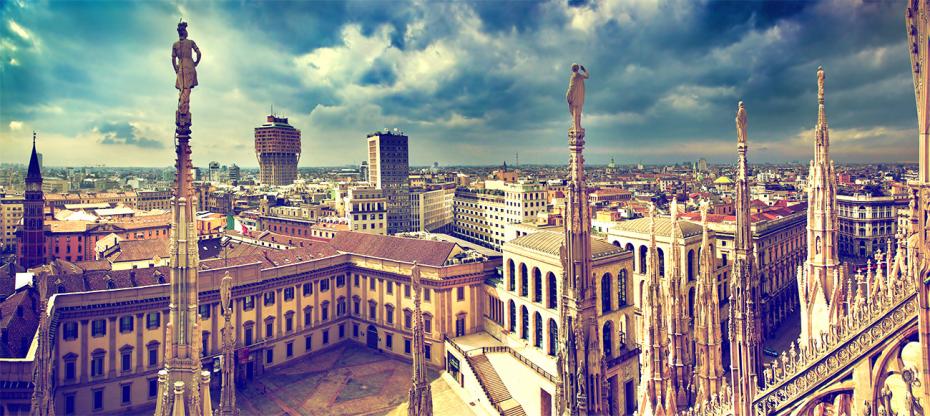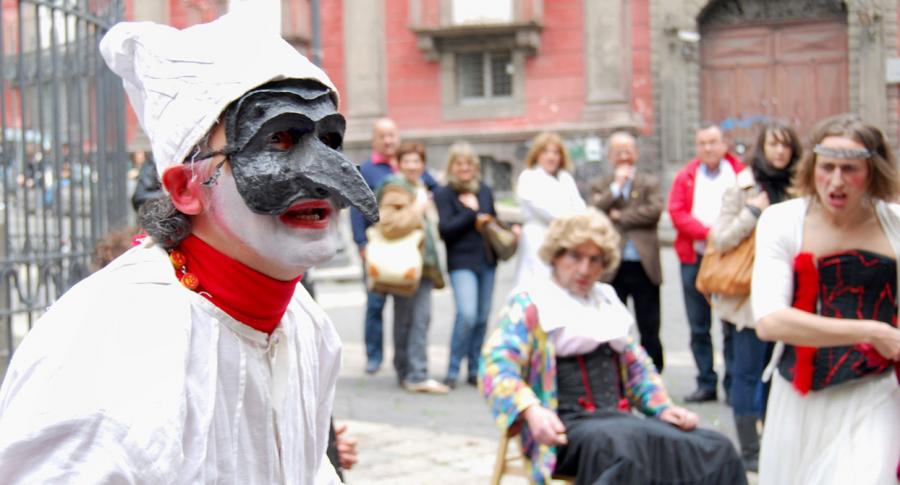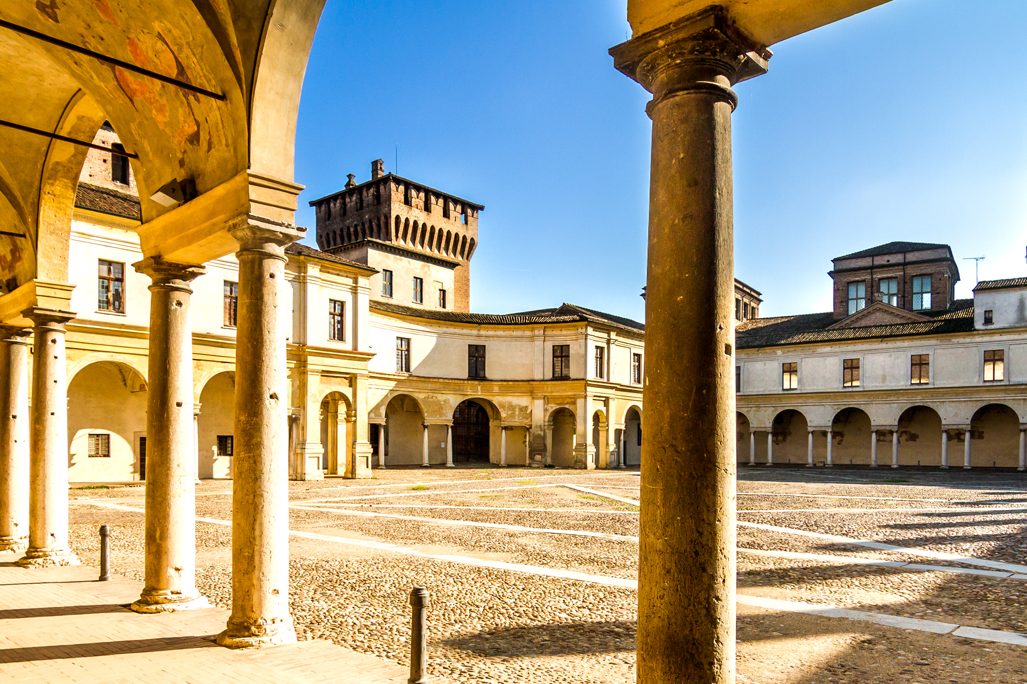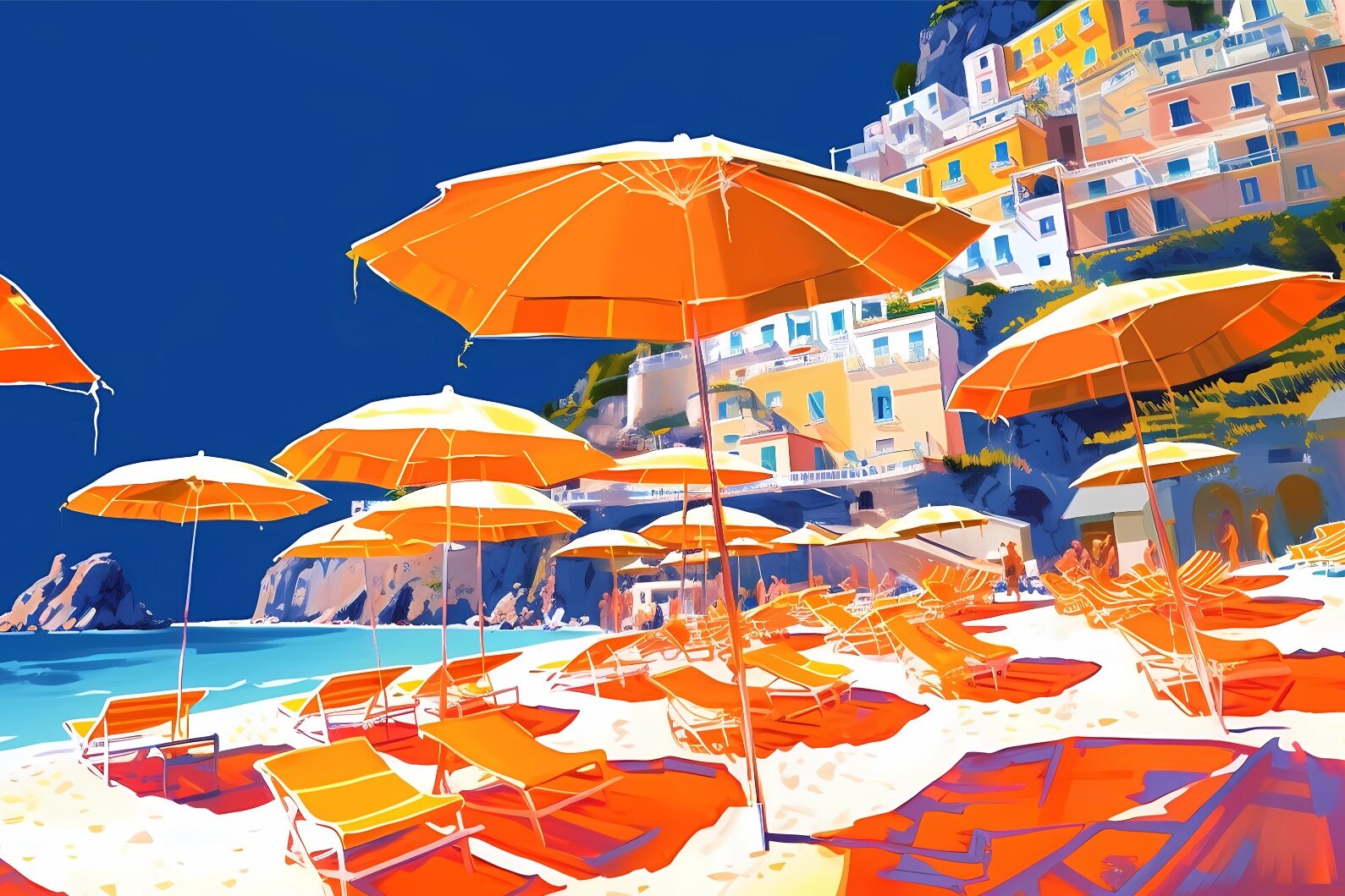Few churches have had a history of construction as long and laborious as the one of the cathedral of Milan, also called the Duomo. It was an impressive undertaking that for more than six centuries involved all of Lombardy and parts of the rest of Italy. During this long period the building miraculously managed to remain coherent to the initial Gothic design.
For this reason, when faced with a project that is taking too long or is never-ending, the people from Milan say that it is like the building of the Duomo (“la fabbrica del Duomo”). The Milanese people are very proud of their huge cathedral and regard it as the very emblem of their city. Dedicated to Maria Nascente, that is, Saint Mary of the Nativity, the Duomo is topped by a golden statue of the “Madunina” (the little Madonna in the local dialect) shining against the sky on top of the highest spire.
The church was built on the site of the eleventh century Basilica of Santa Maria Maggiore, and the construction started in 1387. Through this church, and owing mainly to the influence this church exerted, the Gothic style penetrated Italy from beyond the Alps, also providing an inspiration for the “gotico fiorito” (the flowery Gothic), a style characterized by delicate stone ornamentations looking like flowers. This style was later to influence many of the buildings in Venice. Think of the Ca’ d’Oro, for instance.
The vast square in front of the Duomo (in Italian “il sagrato”), is rectangular; in its middle looms the monument to King Victor Emmanuel II (1896), a large monument that looks puny against the mass of the cathedral. The Duomo is the largest monument in Milan, and it is also the largest Gothic church in Italy. The Duomo is also the third largest church in the world.
Throughout the centuries, dozens of architects and artists participated at the construction of the Duomo and made it the marvelous church that it is today. And the construction is still ongoing! A list of the numerous architects who worked on the Duomo at different times exemplifies, in a way, the history of art of the region. In 1400 Filippino degli Organi designed the apse, the vault and the terraces. In 1418 Pope Martin V consecrated the main altar. During the period of the Sforza lords, and mainly due to their input, the construction went ahead speedily. In the fifteenth century, three generations of a family of artists, the Solari, worked on the Duomo, one after another: Guiniforte, Giovanni, and Pier Antonio. Although Italian art in the fifteenth century was already predominantly in the style that we now call Renaissance, architect Giovanni Antonio Amadeo, son-in-law of Guiniforte Solari, won the competition for the completion of the Gothic style building.
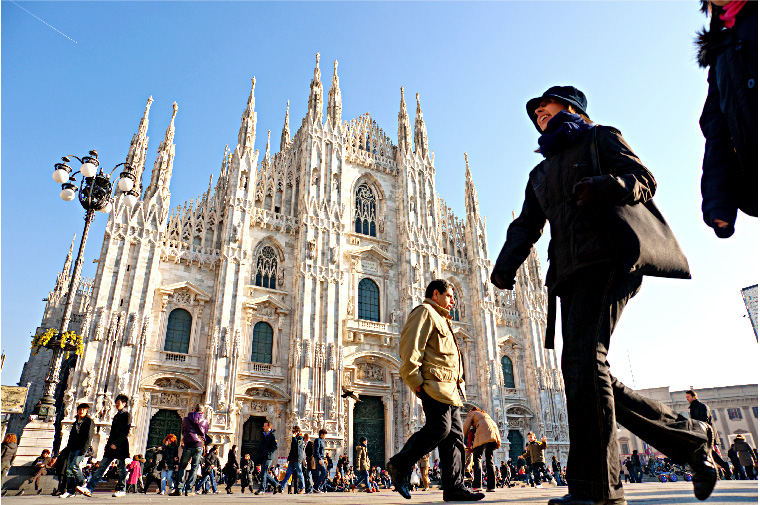
Amadeo, a strong proponent of the Gothic style, implemented the first four spires. Later, in 1567, the famous archbishop of Milan, later sanctified as Saint Carlo Borromeo, ordered his favorite architect, Pellegrino Pellegrini, to complete the façade. In 1572 San Carlo re-consecrated the altar. After Pellegrini left for Spain, several other architects took over the seemingly never-ending job, including Lelio Buzzi, who also built the magnificent Biblioteca Ambrosiana. Cardinal Federico, another great archbishop issued from the same noble Borromeo family, entrusted the task of completing the construction to Fabio Mangoni. Architects Richini and Quadrio followed. During the seventeenth century, the façade took on a more and more evident Gothic appearance, when hundreds of spires where added. Needless to say, in the eighteenth century the construction was not yet completed. In 1765 the tallest spire was installed, but the famous golden statue of the Madonnina, which tops the whole building in its golden glory, went up only in 1774.
In 1805 Napoleon I gave architect Carlo Amati the task of completing the church. Spires, statues, turrets and terraces continued to be feverishly added: there exists a special marble quarry destined solely for the Duomo. The façade, according to the scheme originally proposed by Pellegrini, was completed between 1805 and 1813. Napoleon can be credited for speeding up the work considerably.
In the wake of major victories in Europe, Napoleon I created The Republic of Italy on March 17, 1805. Then, remembering that he was Italian after all, Napoleon created the Kingdom of Italy, and was consecrated and crowned king in the Duomo on May 26 of the same year. Actually, he crowned himself, grabbing the crown and placing it on his own head, while famously exclaiming:”Dio me l’ha data e guai a chi me la toglie!” ( God has given it to me, and woe to those who dare take it from me). He was referring to the Corona di ferro, the Iron Crown, the legendary crown of Lombardy and the crown of the Carolingians. It is thus named because it is said to contain an iron nail from the cross that crucified Christ. In this way Napoleon deemed to gain royal legitimacy by tying himself to Charlemagne, the first ruler to be consecrated with this very crown.
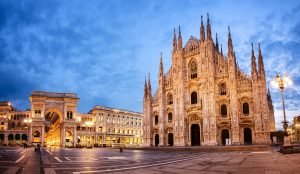
Even during the time that it was being built the Duomo needed continuous repairs and restorations. In recent times two major restorations have taken place, the first in 1935, and the second, more massive and extensive, after the end of World War II, during which industrial Milan was repeatedly and savagely bombed. Allied bombings did not spare the historic center, and during that time many structures and statues crumbled to smithereens. Fortunately and with good foresight, the ancient stained glass windows were taken down and safely stored. After the war ended, major repairs were needed, and in fact only on December 8, 1966, was the new “sagrato” inaugurated.
Let us talk of dimensions now. Milan’s Duomo is the second largest church in Italy, after St. Peter’s Cathedral in Rome. The church consists of 11,700 square meters and its exterior is 157 meters long. It has 135 spires, the tallest of which is 108 meters high. The marble is pinky white with bluish streaks, and its surface has recently been cleaned. There are 2,245 statues externally, but, counting the statues inside, there are a total of 3,159. There are also 96 gigantic gargoyles, rivaling in size and horrific appearance those of Notre Dame in Paris. The statues represent saints, prophets and biblical figures. The bronze doors present episodes from the life of Saint Ambrose, the saint patron of Milan (a city therefore also called “la città ambrosiana”), and from the life of Mary.
Entering the Duomo, one has the feeling of coming into a forest, a large dark wood with enormous trees (the interior pillars) holding up the distant vault. The light is filtered through the magnificent stained glass windows, creating a soft rainbow effect. One is filled with awe, moved, and taken spiritually upward. Underneath the church, an underground chapel houses the body of Saint Carlo Borromeo, dressed in vestments adorned with precious gems and encased in an urn of rock crystal.
The climb to the terraces is arduous and not to be recommended to those who suffer from vertigo. The roof is remarkably flat, and in olden days the Milanese used to go up to have a picnic while enjoying a good view of the Alps and the nearby pre-Alps. Up there they could also admire the statues and the gargoyles from close up. A narrow stone ladder takes all the way up to the Golden Madonnina, called, in Milanese dialect, with the diminutive “Piscinina” (the little one), but that is actually a statue four and a half meters tall. From the top of the Duomo you can see on the south side the Royal Palace, housing the Museum of the Duomo on the ground floor. There the originals of many valuable statues have been placed for safekeeping. In room 13 there are terracotta models of the Madonnina, designed in 1771 by Giuseppe Perego.
The Milanese, unlike most Italians, do not sing much. But one song in Lombard dialect is always quoted and sung:
O mia bela Madunina
Che te brilet de luntan
Tuta dora e piscinina….
(O my beautiful little Madonna, you who shine from afar, all so golden and so small….)
When they sing this song, many Milanese people are moved to tears. Including myself. You see, Milan is my hometown.
